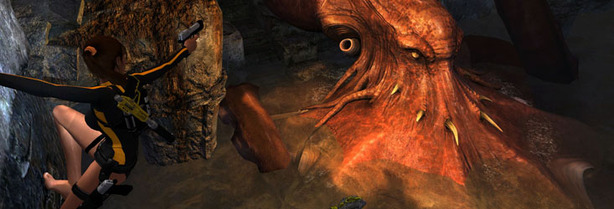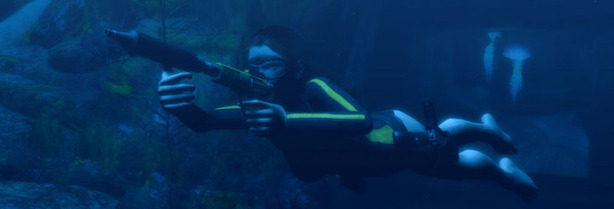
Underwater with Lara Croft
Lara’s underwater antics have, ever since the second game, usually been more about fan service than really expanding the gameplay. Everyone knows that Lara handles like an eighteen-wheeler with no tires when she’s under water – but we’re prepared to cope with it in order to see her in a swimsuit.To a degree, that still hasn’t changed much in Tomb Raider: Underworld. Lara’s wetsuit is still gloriously or depravedly skimpy depending on how mature you’re feeling when you see it, with the neoprene barely covering half her body and her legs wiggling free like some curiously sexy eels with enormous polygon counts.
Elsewhere though, things have certainly changed and Lara’s controls have been completely re-tightened and loosened in all the right places. The new Lara handles as gracefully as she should when she’s in the ocean and even the threat of omni-directional combat with sharks is made fun thanks to the speargun and targeting system.
The improvements aren’t all on Lara’s end though, as it’s the level design which plays a massive part too. Instead of confining Lara’s mermaid impressions to tight underwater corridors with levers, gates and only periodic places to stop for air, Lara has a decently sized reef to look around in and some high-tech scuba gear.
Scuba gear isn’t the only gadgetry that Lara has access to though. Her arsenal has been completely rejuvenated above and beyond the simple magnetic grappling hook of Legend.
The centrepiece to Lara’s new tools is her swanky PDA, which is replete with a sonar scanner and journal system. Both of these can play a part in helping Lara complete her missions, though the hardcore platforming elite will probably prefer to forego using it at all.
The journal system is fairly simple and is just a catalogue of Lara’s thoughts and musings. If you find yourself getting lost or don’t have an idea on how to solve one of the huge and multi-levelled puzzles that have been built into the game then you can tap into the journal and get Lara to think on the problem a bit. She can offer both gentle reminders, such as directing you to look at a certain part of a mechanism, or she can give more explicit clues about how to solve a set puzzle.
That’s all pretty basic stuff then, but the sonar pulse is where the game gets really clever. Lara’s PDA comes equipped with a high-frequency scanner that can emit a quick burst of sonar and watch how it travels out around her. By doing this Lara can map out complex areas and view a simplified virtual map of the world. It only shows her everything within line-of-sight, but it shows ledges that she can move over very clearly and is thus handy for navigation.
The sonar tool is pretty much needed too, as one of the focuses the team at Crystal Dynamic had for this Tomb Raider game was on making the world look a bit more natural. The block-like ledges and netted climbing textures of previous games have been done away with in favour of realistic outcroppings, hidden crevices and curved surfaces.
Normally, creating a character that can animate correctly in these areas would be hard work. The reason that the older games had re-used textures for climbing on, for example, was simply because Lara had just one climbing animation, so the texture had to sync up with those movements and hand positions.
With Underworld though, Lara uses a new animation system that blends together dozens of motion-captured movements to create even simple actions. Thus, when Lara climbs a surface she doesn’t simply loop one animation but intelligently looks for the right outcroppings and then blends together a series of animations that will allow her to get there.

MSI MPG Velox 100R Chassis Review
October 14 2021 | 15:04











Want to comment? Please log in.